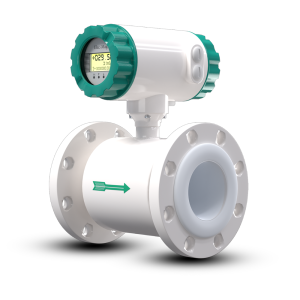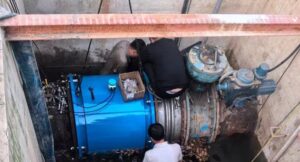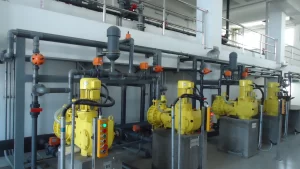In today’s world of precise industrial processes and advanced automation systems, accurate flow measurement has never been more critical. Among the many types of flow meters available, the electromagnetic flow meter—often called a mag meter—stands out due to its reliable performance and non-intrusive design.
But like all instruments, electromagnetic flow meters come with both advantages and disadvantages. In this article, we’ll explore their working principle, where they shine, and where they may fall short. Whether you’re an engineer selecting equipment or a facility manager evaluating systems, understanding the pros and cons of electromagnetic flow meters will help you make informed decisions.
What Is an Electromagnetic Flow Meter?

An electromagnetic flow meter is a type of volumetric flow meter that uses Faraday’s Law of Electromagnetic Induction to measure the flow of liquid in a pipe. According to Faraday’s Law, when a conductive fluid flows through a magnetic field, it generates a voltage that is directly proportional to the flow velocity. This voltage is picked up by electrodes and converted into a flow reading.
Unlike some other flow meters, electromagnetic types contain no moving parts, making them particularly appealing in industries where reliability and maintenance-free operation are essential.
How Electromagnetic Flow Meters Work

To truly understand the advantages and disadvantages of electromagnetic flow meters, it helps to understand how they operate.
Inside the meter, a pair of electromagnetic coils generate a magnetic field perpendicular to the flow of liquid. As the conductive liquid flows through this field, an electromotive force (EMF) is induced. Electrodes on the pipe walls detect this voltage, which is directly related to the velocity of the fluid. Given the cross-sectional area of the pipe is constant, the meter can calculate the volumetric flow rate accurately.
However, non-conductive fluids like oil or gas cannot be measured using this technique, which brings us to the first drawback.
Key Advantages of Electromagnetic Flow Meters
Let’s start by reviewing the main benefits that make electromagnetic flow meters popular across various industries, from water treatment to food processing.
1. No Moving Parts
One of the biggest advantages is that electromagnetic flow meters have no moving parts. This significantly reduces wear and tear, minimizes maintenance, and prolongs the lifespan of the device.
2. Highly Accurate Measurements
Mag meters are renowned for their high accuracy, often in the range of ±0.2% to ±0.5% of reading. This makes them ideal for critical applications where even small measurement errors can have big consequences.
3. Wide Range of Sizes
Electromagnetic flow meters are available in a broad range of sizes, from small pipelines (1/10 inch) to large pipelines (up to several meters). This makes them suitable for everything from residential water metering to industrial-scale operations.
4. Bidirectional Flow Measurement
Unlike some other technologies, mag meters can measure flow in both directions. This is essential in systems where flow reversals may occur.
5. Low Pressure Drop
Because they are non-intrusive, mag meters do not restrict the flow, resulting in negligible pressure drop. This improves energy efficiency and is especially important in gravity-fed systems.
6. Suitable for Slurries and Dirty Liquids
Electromagnetic flow meters excel in dirty or slurry-laden liquids, such as wastewater, pulp, and mining slurries. Their open, obstruction-free design allows solids to pass through without affecting performance.
7. Reliable Long-Term Performance
Given their durable design and lack of mechanical wear, electromagnetic flow meters often offer years of maintenance-free operation, making them highly cost-effective over time.
8. Digital Integration and Smart Features
Modern mag meters come equipped with smart features, including digital displays, diagnostics, and remote data transmission. This makes them a great fit for IoT-enabled industrial setups.
9. Sanitary Options Available
In industries like food and pharmaceuticals, sanitary-grade mag meters with hygienic fittings are widely available. These models meet FDA and 3A standards and can be cleaned in place (CIP).
10. Resistant to Corrosive Liquids
By using linings made from materials like PTFE or rubber, electromagnetic flow meters can handle corrosive fluids, such as acids and alkalis, with ease.
Disadvantages of Electromagnetic Flow Meters
Despite their many advantages, electromagnetic flow meters are not without limitations. Let’s take a close look at the most important drawbacks.
1. Only Suitable for Conductive Fluids
Mag meters only work with fluids that have a minimum conductivity threshold, typically >5 μS/cm. This means they cannot measure pure distilled water, oils, or gases.
2. Higher Initial Cost
Compared to mechanical or turbine meters, electromagnetic flow meters are more expensive upfront. While they often save money in the long run, the initial investment can be a barrier for smaller operations.
3. Sensitive to Air Bubbles and Noise
Large amounts of entrained air or electrical noise can interfere with readings, leading to erratic or inaccurate measurements. Careful installation and grounding are essential.
4. Requires Electrical Power
Mag meters need a continuous power supply to energize the magnetic coils and process the signal. This makes them unsuitable for off-grid or remote installations without a power source.
5. Pipe Must Be Full
To get accurate readings, the pipe must be completely filled with fluid. If air pockets are present, they can cause the meter to under-read or produce false readings.
6. Installation Considerations
Although relatively easy to install, mag meters require specific straight pipe lengths upstream and downstream to ensure accurate readings. Improper installation can compromise performance.
7. May Require Periodic Calibration
Even though they’re low-maintenance, some applications may require periodic recalibration to ensure continued accuracy, especially in regulatory environments.
Common Applications of Electromagnetic Flow Meters
Thanks to their reliability and versatility, electromagnetic flow meters are used in a wide range of industries:
-
Municipal Water and Wastewater Treatment
-
Chemical Processing
-
Food and Beverage
-
Pharmaceutical Manufacturing
-
Mining and Slurry Handling
-
Pulp and Paper Industry
-
HVAC and Energy Management Systems
Their ability to measure corrosive, viscous, and solid-laden fluids makes them a go-to solution for tough conditions where other meters would fail.
Comparison With Other Flow Meter Types
Let’s briefly compare mag meters with other popular types:
| Feature | Electromagnetic | Turbine | Ultrasonic | Differential Pressure |
|---|---|---|---|---|
| Measures Non-Conductive Fluids | ❌ | ✅ | ✅ | ✅ |
| Moving Parts | ❌ | ✅ | ❌ | ❌ |
| Suitable for Slurries | ✅ | ❌ | ✅ | ❌ |
| Pressure Drop | Very Low | Medium | None | High |
| Cost | High | Low | Medium-High | Low |
| Accuracy | High | Medium | High | Medium |
This table makes it clear that while mag meters are not universal, they outperform in specialized applications.
Tips for Choosing the Right Electromagnetic Flow Meter
If you’re considering a mag meter for your system, keep these tips in mind:
-
Verify Fluid Conductivity: Ensure your liquid meets the minimum conductivity requirements.
-
Consider Pipe Size and Flow Range: Match the meter specifications with your operational needs.
-
Check Material Compatibility: Choose a liner and electrode material that resists corrosion from your fluid.
-
Account for Installation Environment: Select appropriate IP/NEMA ratings for wet or hazardous areas.
-
Plan for Maintenance Access: While low-maintenance, ease of access can be helpful for diagnostics.
Conclusion
The electromagnetic flow meter offers a compelling mix of accuracy, durability, and versatility, making it a valuable tool in many industrial applications. Its non-intrusive, low-maintenance design gives it a clear edge in demanding environments, especially where slurries or corrosive fluids are involved.
However, they’re not a one-size-fits-all solution. Their inability to measure non-conductive fluids, higher cost, and power requirements mean they must be chosen with care. When used in the right context, mag meters provide unmatched performance and long-term value.
By understanding both the advantages and disadvantages of electromagnetic flow meters, you can make a well-informed decision that enhances your system’s efficiency and reliability.
We are a manufacturer of automatic flow meters with many years of experience in the industry. We have strong independent research and development capabilities and are a leader in the flow meter industry. Our main products include electromagnetic flow meters, vortex flow meters, turbine flow meters, ultrasonic flow meters, Coriolis flow meters, various solenoid valves, level meters, control units and valves, etc. Welcome to purchase –Best Instrument





